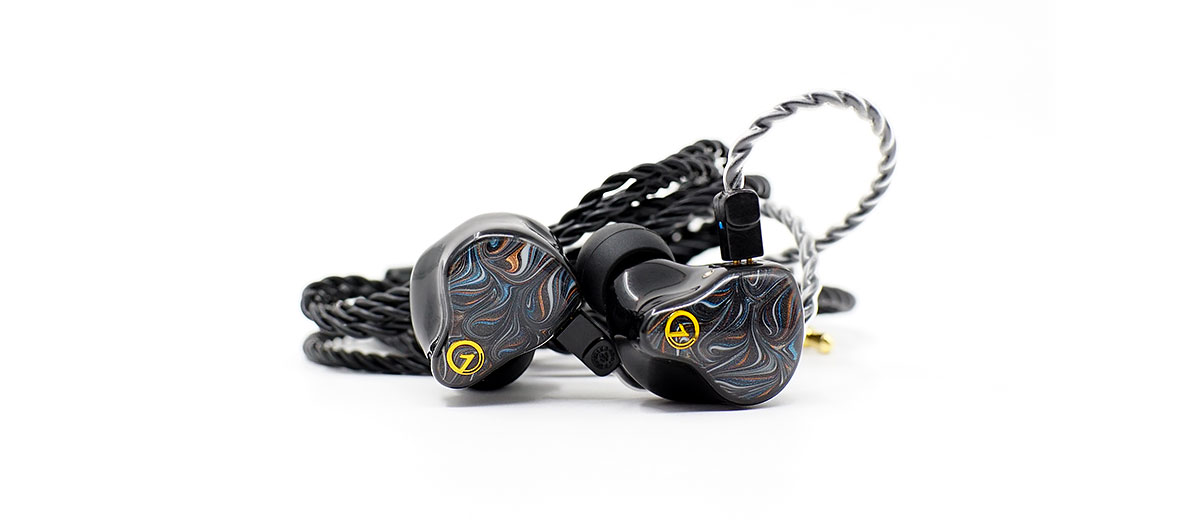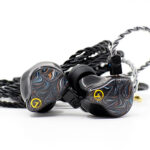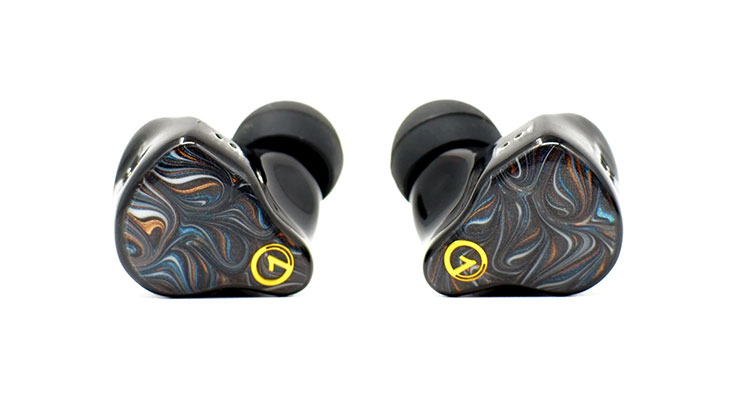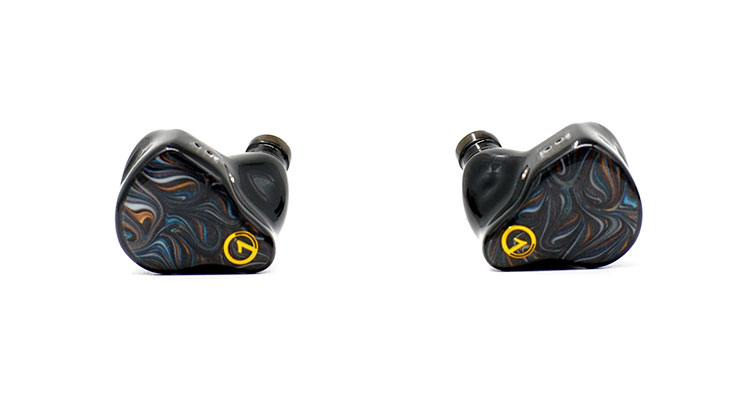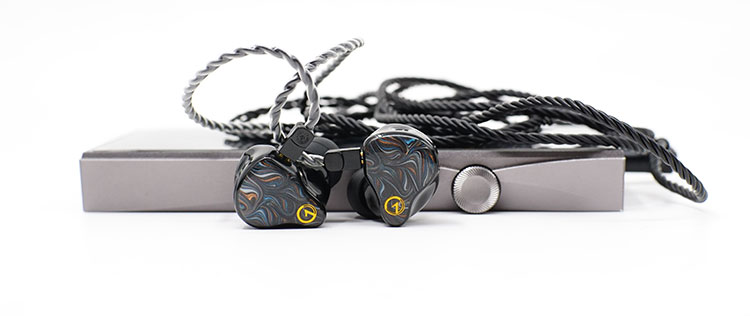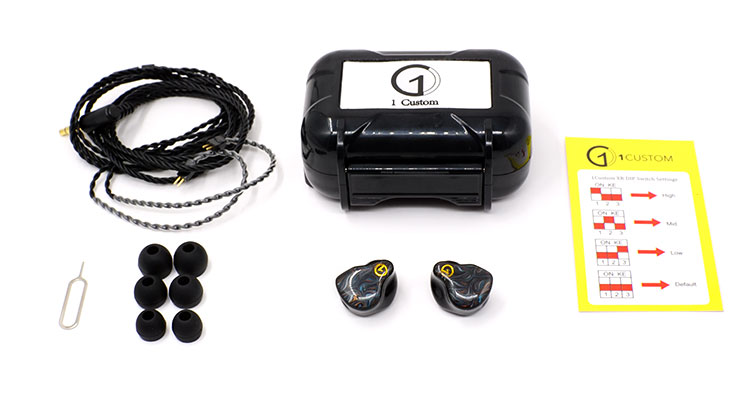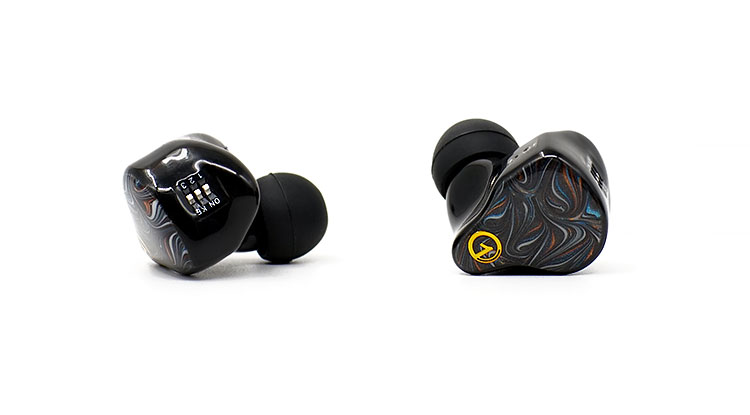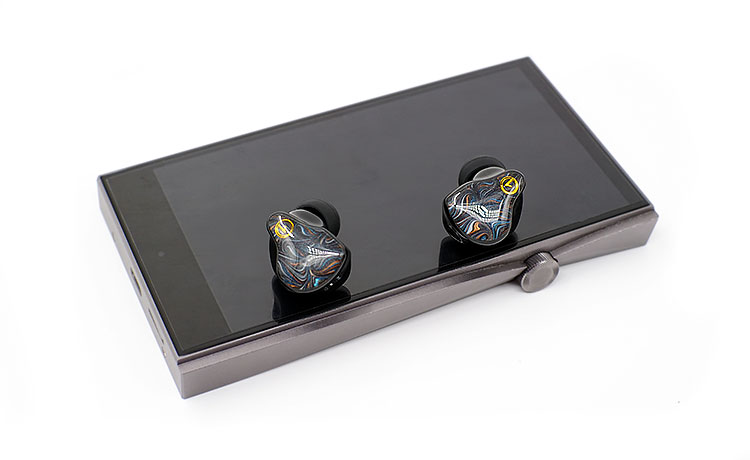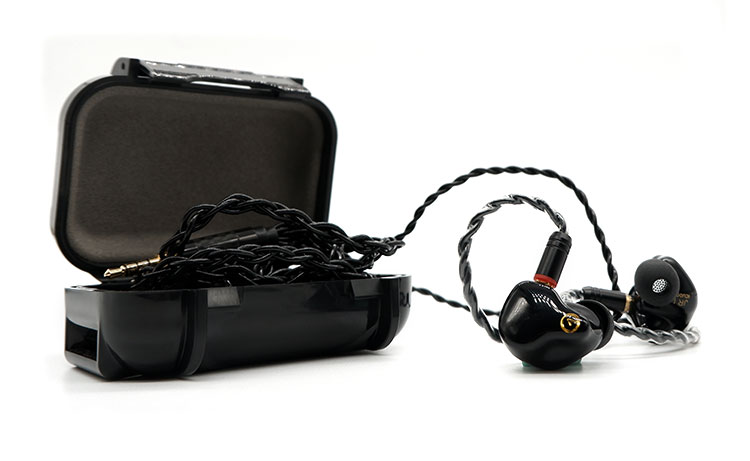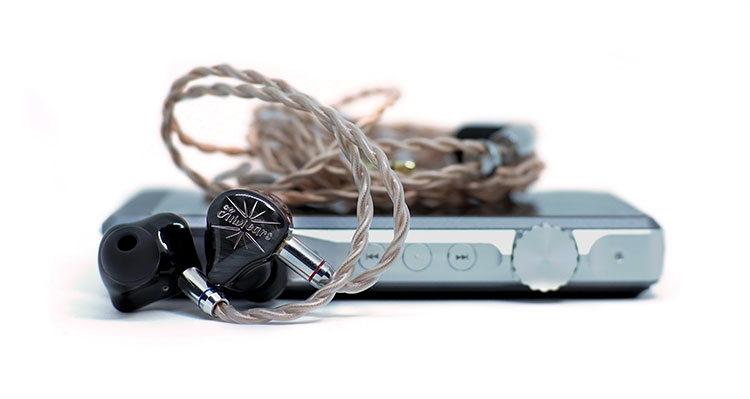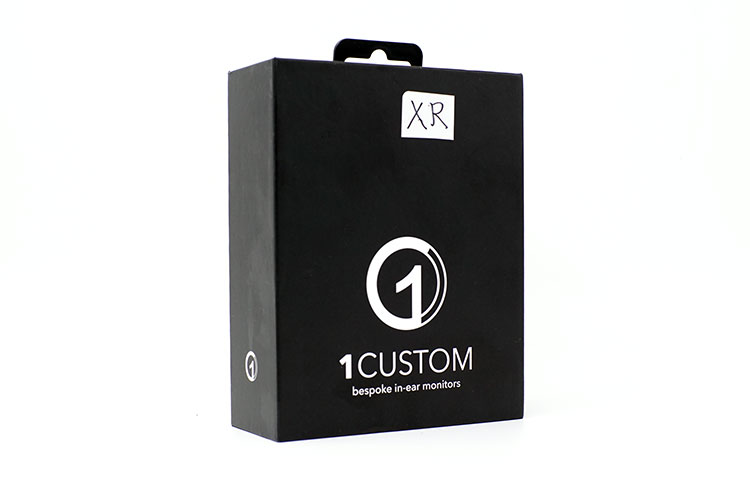We review the 1Custom XR, which is a new dip switch capable eight balanced armature driver universal in-ear monitor with 3 unique tuning modes. It is priced at $559.00.
Disclaimer: This was sent to us as a sample for our honest opinion. Headfonics is an independent website with no affiliate links or services. We thank Jaben for this opportunity.
To read up on more 1custom products we have covered on Headfonics you can click here.
Note, this article follows our latest scoring guidelines which you can read up on here.
Popular SEA audio specialists Jaben have quietly built up the profile of IEM makers 1Custom through their exclusive distribution over the last few years. The label is known for having customizable sound using DIP switches with a steady lineup these last few years.
One such model is the Jr, which we have previously reviewed and it is an entry-level monitor competing in the sub $200 IEM market.
1Custom is back with the new 1Custom XR in 2022. This is their TOTL release this year with its 8 Balanced Armature configuration. It is also the successor of the 1Custom Master “MR”, having the same driver configuration.
Priced at $559, a little over the $500 mark, the 8 BA 1Custom XR is targeted for more serious audiophiles with its price offering.
(Do note because of the ‘newness’ of some aspects of the XR the Jaben website does not carry the product information currently. Please contact Jaben directly for purchase-related questions).
Tech Highlights
If you’re keen on getting a 1Custom IEM, it probably is because of the customization of the sound signature. I was intrigued with the dip switches and I found it the most interesting design with the 1Custom XR.
The dip switches allow users to boost the highs, mids, and lows. All in all, it has a 4-sound setting design which will be covered more on the Sound Impressions.
In terms of specs, not much can be found with the 1Custom XR. They do however mention it to have an 8 BA configuration, with the dip switches that allow sound signature customization.
Design
The 1Custom XR shell has a simple glossy finish overall, with the faceplate having a glittery artistic abstract play of colors, which frankly is quite attractive. Design is identical with the left and right monitors, with a minimalistic subtle gold logo of 1Custom.
The dip switches are found on top, which is easily accessible when configuring tonality. A small vent, which is quite common nowadays, is also found at the bottom of the cable socket.
A molded shell with an ergonomic fit in mind is evident. Curves are evident across all dimensions. It’s nothing out of the ordinary, but very professionally finished.
Comfort & Isolation
The 1Custom XR is fairly light. They are very comfortable to wear, even for long periods. Due to its ergonomic shell, it is pretty seamless such that it fits perfectly in the ears.
The nozzle also has a comfortable length, not deeply inserted into the ear canal, which I like. However, isolation is just average. The stock tips are pretty ordinary, black dome-shaped single-flanged ear tips. Doorbells and alarms can easily pass through when listening.
Stock Cable
There was no available information about the 1Custom XR cable except that it’s an SPC cable. Visually, it is housed in a matte black color. It’s also relatively thin, with a 4-core braided cable with a comfortable length.
It is terminated with a 2-pin 0.78mm and has a 3.5mm L plug. The cable is light, which makes it seamless when moving around. Nothing was out of the ordinary in terms of microphonics. The wire sits comfortably at the back of the ears, with good memory retention.
Packaging & Accessories
The 1Custom XR model came in the standard 1Custom Box with a white sticker with the XR label on it.
Inside the magnetic flap are foam inserts that keep the items in place. The package includes the in-ear monitors, cable, carry case, DIP switch setting manual, DIP switch tool (looks like a sim ejector), and 2 extra tips.
The carrying case is a nice sturdy black plastic clamshell box, same across all 1Custom monitors. Inside are 2 thin foam inserts, one above and below, that keep the IEM safe. It’s spacious enough to fit the 1Custom XR and cable comfortably.
Sound Impressions
Bass
With the 1Custom XR having an 8 BA configuration, I had very low expectations of its bass response. True enough, the sub-bass does not go low like how a dynamic driver does. The mid-bass is also very lean, although it is slightly amplified with bass-heavy tracks.
Although, I find the bass response to be fast and detailed. It is tight, with a natural bass response, which is emphasized with bass guitar-heavy songs. With fast bass rifts, notes are also precise and distinguishable. Successive notes are distinct and well-controlled such that it does not bleed into each other.
Mids
Extended listening brings out the best of the XR – the midrange region. It is clear and articulate. They are tuned a bit forward, which makes the midrange region shine and pretty much enjoyable.
To describe the midrange further, it is mostly even, with the right balance between the lower and upper midrange. Although similar to other pure BA monitors, it is a bit cold, but still tuned very well.
Instruments sound natural with the XR. Piano notes are detailed, wherein sustains are heard clearly. Although, in some instances, particularly with strings, notes in the lower midrange frequencies appear to be thicker in tonality.
Male and female vocals are also surprisingly impressive, with emphasis on female vocals. Vocal textures are replicated very well. They are articulate, such that vocal tonality and vocal techniques, to name a few, stand out.
Treble
Treble is very crisp and light, with just the right aggressiveness to have a well-extended treble, while maintaining no harshness in the highs. It is steered to be a bit bright, with a comfortable tuning that fits well with the bass and midrange of the XR.
High frequencies also have the right amount of sparkle and airiness around it. In particular, guitar strums are crisp and cymbals are splashy. Every pluck and brush are heard.
The XR also did well with its good control and clarity on its highs. There were no audible dips in the high frequencies. It is smooth and consistent. It felt very natural, with no sibilance and harshness across different genres.
Staging
Staging on the XR is pretty impressive for its price range. It is deep and wide. It is spacious enough to have a good idea of the positioning of different instruments and vocals.
Imaging is also accurate with these monitors, exceptional even. Gaps are wide with both instruments and vocals, which is extra highlighted when listening to busy tracks. Sound is also multi-directional, wherein sound is found in a 3-dimensional space.
DIP Switches
Inside the box, there is a card that indicated the switch position with its sound setting. The red areas represent the switch position.
These sound settings are no gimmick. It was surprising how these switch positions change the sound of the monitor. The settings are straightforward, the mode enhances and gives focus on the said frequency’s response.
High Mode
With the Default mode, the XRs are already a bright monitor. I was quite skeptical about boosting the treble, but instead, this setting has pushed more detail and clarity in the vocal and upper frequencies. The bass response also is drastically decreased, which gave way for more details to be heard.
Mid Mode
The Mid mode gave focus on the midrange region of the XR. With this setting, Treble and Bass are drastically decreased. In effect, vocals and instruments are more articulate. In particular, vocal textures are richer and more pleasing to listen to.
Low Mode
The Default mode of the XR has shown a lack of Bass in the overall sound signature. However, with the Low Mode, bass response is significantly boosted, such that rumbles in the sub-bass regions are heard. Bass notes and drum beats also are thicker, making this monitor more fun and enjoyable.
Synergy
Efficiency
With an impedance of 32 ohms, the XR is not difficult to drive. Smartphones already do a great job in powering up the XRs at a good listening range.
Dedicated audio players such as the iBasso DX150 and Astell&Kern SE 100 further enhance the listening experience with the XR. Both DAPs can easily power the 1Custom XR, with no unwanted noise observed.
Pairings
The 1Custom XR is a very flexible monitor, especially due to its DIP Switch Settings, which makes it easier to pair with different DAP sound signatures. However, BA monitors are best paired with dark or warm DAPs to help in boosting its mid and sub-bass regions. I wouldn’t recommend a bright DAP, given that the XR already has an elevated treble region.
The iBasso DX150 with AMP 6, known to have a natural sound signature and warm tonality, would be a good pair with the Default Mode of the XR. The Bass is still a bit lean for my preference, but overall it complemented in producing a warm and rich midrange region.
The Astell & Kern SE100 with the XR’s Low Mode is also a good pairing. This combination produced a thicker bass and midrange, which produced a good balance on the brightness of the XR. Vocals and dynamics are also better when paired with the SE100.
Select Comparisons
1Custom Junior “JR”
$138.26
Technical
The 1Custom Junior is a hybrid universal IEM featuring a single dynamic driver and 2 balanced armatures. The Junior is 1Custom’s entry-level hybrid monitor while the XR is its TOTL offering with an 8 Balanced Armature configuration. Both have similar DIP Switch Settings that let users customize their sound signature.
Design
The JR and XR’s shells are identical with minor differences. They both have the black glossy shell with DIP switch settings – XR’s 3 DIP switches vs JR’s 2 DIP switches. Despite the XR having more DIP switches, both have 4 sound settings.
Another difference is its faceplate. JRs have a plain black faceplate while the XR has an abstract art design, which shouts premium – compared to a plain black design.
1Custom ditched the MMCX termination on its JR, with the XR having a 2-pin socket. The cable on the JR is noticeably thicker with a 16-core vs XR’s 4 core SPC. Both monitors have a 3.5mm termination, JR with a straight jack and the XR with an L jack.
Performance
Bass is more elevated on the JR, which is frankly, not surprising, with its hybrid configuration. Dynamic drivers have the extra push in the sub-bass region. The XR, with its 8 BA configuration, does however offer an adequate bass response. Unfortunately, it still falls short with JR’s rich bass response.
The midrange region, being the strength of the XR, says a lot about the 2 monitors. Even though the JR does generally well on its details and textures, the XR is just a notch ahead.
It cannot compete with 1Custom XR. Details are better revealed with the XR. In particular, some vocal layers are veiled with the JR, which is heard in the 1Custom XR. Instrument textures are nowhere near XR’s replication.
The 1Custom XR has a more elevated treble of the two monitors. Comparing the 2, the XR has better control treble extension in the high frequency. Detail retrieval is significantly better in the 1Custom XR. The JR does not have the airy and sparkle finish that can be heard in the XR. Hi-hat hits are soft with the JR, where it is nowhere as clear, detailed, and splashy with the XR.
The soundstage is narrower with the JR. Even though it never felt cramped with the JR, the 1Custom XR’s soundstage is impressively wide and deep. Imaging is also on another level with the 1Custom XR. Gaps between multiple instruments and vocals are more noticeable apart compared with the JR.
The difference between the two monitors is not at all surprising, given the price difference. But it gives us a clearer picture of how these 2 are different and catered to different demographics.
Kiwi Ears Orchestra
$499
Technical
Both the Kiwi Ears Orchestra and 1Custom XR are equipped with an 8 balanced armature. The difference between these 2 monitors is the 1Custom XR’s ability to customize users’ preferences through the use of its DIP Switch Settings.
Design
Both monitors have a similar design- artistic, simple, and neutral. Kiwi ears have a paint-brush-like texture design on their ergonomic black shell which changes color as it absorbs UV light. 1Custom on the other hand an abstract-art design on a similar glossy black shell.
A 2 pin 0.78mm termination with an ear-hook design is found in both of the monitors. The cable of the Orchestras is heavier and thicker than the 1Custom XR, giving the impression that it’s more premium in terms of quality. Both cables are terminated with a 3.5mm jack, with the Orchestra having a straight plug and the 1Custom XR having an L jack.
Performance
Both monitors have recessed lows. The Orchestra and 1Custom XR have a conservative bass tuning, detailed and accurate, despite not having the deep rumble in the sub-bass region and a full presentation in the mid-bass region.
The 1Custom XR has a more elevated bass, even in default mode. Drumbeats also sound more natural with the 1Custom XR, having an airy deep punch. Orchestra’s drumbeats are a bit pale in comparison, bland even.
The midrange region is the strength of the two monitors. Both monitors have an even midrange region, with a natural tonality on both vocals and instruments.
The Orchestra does better with its fuller and richer presentation. In particular, wind instruments are thicker and have a more articulate texture on the Orchestra. Coarseness and vibrations on the trumpets are retrieved better and fuller, capturing its liveliness.
Vocals have similar clarity and detail and sound incredibly rich. One thing I noticed is that the sound on the Kiwi Ears is a bit warmer and more relaxed than the XR.
Both monitors have a good treble extension with comparable detail retrieval. However, 1Custom XR appears to have more energetic highs than the Kiwi Ears Orchestra.
Treble appears to be clearer and crisper on the 1Custom XR, perhaps due to its more forward treble region. Cymbal splashes and guitar string scratches sound more apparent in the 1Custom XR. The Orchestra’s treble seems to be tuned to be too conservative compared to the 1Custom XR.
The soundstage on both monitors is above average. They are both wide and deep, respectable for their price range. The 1Custom XR does however have a slightly wider soundstage. The sound is freer and more spacious, which is impressive. Imaging on both monitors is impressive. Both monitors do a great job of replicating a multi-directional presentation.
Our Verdict
The 1Custom XR lives up to its name as a “custom” monitor where the sound signature can be configured to each person’s reference. 1Custom has leveraged its knowledge of customer preference and produced a product that casts a wide net that I feel quite a lot of discerning audiophiles will enjoy.
The DIP Switch design might not appeal to everyone. However, each switch setting different sound signatures was palatable and unique. With the XR, it felt like having several IEMs for the price of one.
If you’re the type who enjoys different sound signatures with different sound genres, I would have to say the XR is an interesting offering and a strong contender at its price point.
1Custom XR Specifications
- Driver: 8 Balanced Armature
- Impedance: 32Ω
- Cable: SPC
- Connector: 2 pin
- Termination: 3.5mm Stereo

